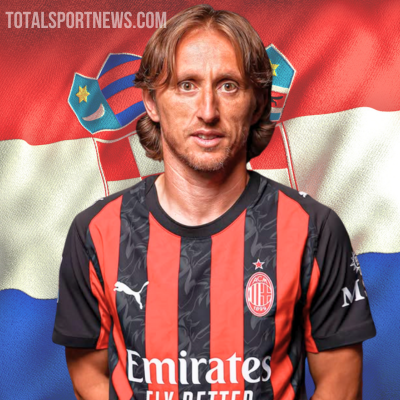🇭🇷🔴⚫ Luka Modrić Lands in Milan: A New Chapter Begins for the Croatian Star in Italian Serie A 🇭🇷🔴⚫
Last Monday, on July 14, 2025, Luka Modrić officially arrived in Milan to kickstart a thrilling new chapter with AC Milan. The Croatian star was welcomed at Malpensa Airport around 11:00 local time, immediately heading to the medical unit at Centro Ambrosiano. A charismatic “Hola everyone, I just landed in Milan… I’m so happy to start this new chapter!” greeted fans via Instagram—perfectly capturing his enthusiasm for his new adventure with the Rossoneri.
Modrić signed at 17:00 a one-year deal (with an option to extend until June 2027) and will adorn the iconic No. 14 shirt in tribute to both Johan Cruyff and Carlo Ancelotti. Now 39 (turning 40 in September), Modrić leaves behind a glorious 13-season tenure at Real Madrid and embarks on a mission to strengthen Milan’s midfield.
📜 From Zadar to San Siro: Modrić’s Storied Journey
Early roots
- Born September 9, 1985 in Zadar, Croatia.
- Joined Dinamo Zagreb’s youth setup at age 16. After loans (Zrinjski Mostar, Inter Zaprešić), he tallied 128 caps and 32 goals, helping win three league titles, two Croatian Cups, and one Super Cup
Premier League breakthrough
- In 2008, Modrić transferred to Tottenham Hotspur: 159 appearances, 17 goals across four seasons.
Legend in white
- Moved to Real Madrid in 2012. Over 597 games, scored 43 goals and collected 28 trophies: 6 Champions Leagues, 4 La Liga titles, 5 Club World Cups, and more.
- Awarded the Golden Ball in 2018.
- Ended Real Madrid stint after a 4–0 loss to PSG in the Club World Cup semis and an emotional farewell at the Bernabéu on May 24
Croatia legend
- Croatia’s captain and most-capped player (188 caps, 28 goals)
- Led Croatia to the 2018 World Cup final, earning the Golden Ball as tournament MVP.
📊 Modrić Numbers
|
Team |
Caps |
Goals |
Major Trophies |
|
Dinamo Zagreb (2004-08) |
128 |
32 |
3× HNL, 2× Cup, 1× Super Cup |
|
Tottenham (2008–12) |
159 |
17 |
– |
|
Real Madrid (2012–25) |
597 |
43 |
6× UCL, 4× La Liga, 5× Club WC, etc. |
|
Croatia (2006– ) |
188 |
28 |
WC Final 2018 (Golden Ball) |
💬 “Are We Here to Win?”—Modrić’s First Words as a Milanista
Igli Tare, Milan’s sporting director, explained they sought a leader to instill experience, passion, and winning mentality. His words echo in Modrić’s first question upon signing: “Will we be a team made to win the championship?”. The Croatian is keen to win also in Milan after a long successful career.
Modrić’s arrival indeed isn’t purely about nostalgia — it’s a strategic move by Allegri’s project to rebuild Milan’s presence in Serie A and the Coppa Italia, while ensuring consistent playing time ahead of the 2026 World Cup .
🧵 Parallels with Zvonimir Boban: Croatia Meets Milan Through the Ages
Just as Modrić arrives as a Croatian midfield maestro, Zvonimir Boban paved the way in the 1990s. Their stories intersect across national pride, midfield genius, and Milanese success.
Boban’s Milan Legacy
- Joined Milan in 1991, logging 251 caps and 30 goals from 1991–2001
- Won 4× Serie A, 1× Champions League ‘94, 3× Supercoppa Italiana, and 1× European Super Cup.
- Notably scored in 37 UCL games .
- Captained Croatia to World Cup bronze in 1998 after playing for Yugoslavia
Shared Traits
- Croatian midfield artistry & leadership: Boban and Modrić both embody class, vision, tactical intelligence, and national representation.
- Cultural ambition: Boban became a symbol of national identity while Modrić’s maturity and World Cup success similarly inspire national unity.
- Post-career intellect and influence: Boban earned a history degree, worked in journalism and club leadership, once saying: “Learning new stuff serves one solely to understand the insignificance of one’s knowledge.” Modrić, too, is known for his reading and reflective style.
- Bringing leadership to Milan: Boban lifted Milan’s midfield with charisma and class; Modrić is expected to mirror that, serving as the midfield engine and cultural bridge in Allegri’s squad .
🔍 Why Modrić’s Milan Move Matters
- Tactical anchor for Allegri
His deep-lying playmaking and elite positioning counterbalance the influx of younger talents like Musah, Loftus-Cheek, Fofana and Ricci. - Serie A revival
At nearly 40, Modrić chose Milan over leagues like MLS or Saudi. - National team synergy
Consistent club action keeps hopes alive for the 2026 World Cup—a vital motivator for Modrić and a boost to Croatia’s hopes . - Marketing and mentorship
Modrić attracts both global attention and local wisdom, positioning him as both icon and mentor in San Siro’s changing room.
🎯 In Summary
Luka Modrić’s arrival in Milan is more than a headline – it’s a narrative of legacy, national identity, leadership, and rebirth. At 39, he offers Milan a rare blend of elite pedigree and steadfast ambition. As he reunites Croatia’s midfield excellence at San Siro, echoes of Zvonimir Boban resonate – uniting past, present, and future in one compelling Croatian story.
🇭🇷🔴⚫ Imaginary Milan Croatia line-up
Many players from Croatia have already played in different seasons for Milan and we can create an imaginary starting eleven. The team would play with three defenders: Simic (4/1), Smoje (6/0) and Strinic (0/0) and the midfield would play with Pasalic (24/5), Boban (178/21), Modrić and Halilovic (3 games in Europa League).
The strikers would be Rebic (100/27), Kalinic (31/6) and Mandzukic (10/0).
The goalkeeper would be Zeljko Kalac, former Australian goalkeeper of Croatian descent. He started his career with Sydney Croatia (later Sydney United).

